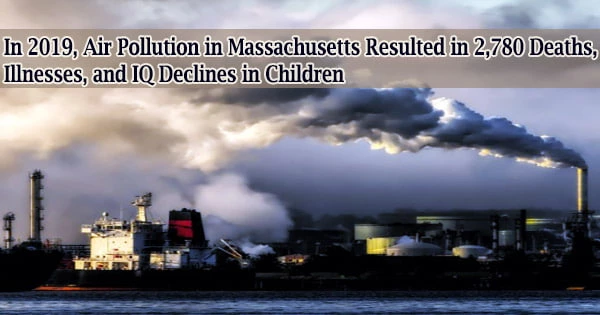According to a recent study by researchers at Boston College’s Global Observatory on Planetary Health, air pollution continues to be a silent killer in Massachusetts, causing an estimated 2,780 deaths a year and measurable cognitive loss in Bay State children exposed to fine particulate pollutants in the air they breathe.
The Barr Foundation funded the study, which is the first to investigate the state’s extensive public health effects of air pollution town by town. The study indicated that independent of demographics or income level, air pollution-related illness, death, and IQ reduction occurs in every city and town. The cities and towns with the worst economic and social conditions had the highest rates.
According to the study, which was released today in the journal Environmental Health, the Boston College team calculates that the combined effect on young children’s cognitive development in Massachusetts in 2019 was a loss of nearly 2 million Performance IQ points or more than 2 IQ points for the typical child. The researchers found that IQ decrease affects children’s academic performance and graduation rates.
“We are talking about the impacts of air pollution at a very local level in Massachusetts not just statewide,” said lead author Boston College Professor of Biology Philip J. Landrigan, MD, director of the Observatory.
“This report gives the people in every city and town the opportunity to see for themselves the quality of the air they and their families are breathing and the dangerous health implications for both adults and children as a consequence of air pollution.”
“All of these health effects occurred at pollution levels below current EPA standards,” Landrigan noted.
2019 saw an average of 6.3 micrograms of fine particle pollution per cubic meter across Massachusetts, with levels ranging from a low of 2.77 micrograms per cubic meter in Worcester County to a high of 8.26 in Suffolk County. The World Health Organization’s suggested level is 5, but the U.S. Environmental Protection Agency’s standard is 12 micrograms per cubic meter.
“Clearly, current EPA air pollution standards are not adequately protecting public health,” Landrigan said.
Due to a lack of air quality monitoring stations in the state, town-by-town air pollution data is often not accessible. The group used the data that was readily accessible and computer modeling to calculate levels for all cities and villages.
We are talking about the impacts of air pollution at a very local level in Massachusetts not just statewide. This report gives the people in every city and town the opportunity to see for themselves the quality of the air they and their families are breathing and the dangerous health implications for both adults and children as a consequence of air pollution.
Professor Philip J. Landrigan
While Massachusetts complies with federal clean air standards and air pollution in the US has decreased by 70% since the passage of the Clean Air Act in the 1970s, when Landrigan and other scientists were successful in pushing for the removal of lead from gasoline, unclean air still poses health risks at current levels to both healthy people and those with other illnesses or ailments.
“We do not have the level of air pollution you see in China or India and because it is mostly invisible today people tend to forget about air pollution and we get complacent,” Landrigan said.
“We hope to break through this complacency and increase awareness. Air pollution is killing 2,780 people in Massachusetts each year, nearly 5 percent of all deaths in the state, and that is a big deal. Air pollution is something we can fix. We know the steps that need to be taken to reduce fatalities and the impact on our children and grandchildren. Now citizens in every city and town across the Commonwealth need to urge our elected officials to take those necessary steps.”
Additional findings include:
- At least 2,185 of the 2,780 deaths in Massachusetts in 2019 that were linked to air pollution were caused by lung cancer, 1,677 by heart disease, 343 by chronic lung disease, and 200 by stroke.
- Children with asthma accounted for 15,386 instances, and 308 newborns were born underweight, according to estimates, due to air pollution (5.5 lbs. or less).
The burning of fossil fuels is responsible for more than 95% of the air pollution in Massachusetts. Two-thirds of pollutant emissions, or 655,000 tons, were produced by cars, trucks, buses, airplanes, trains, and ships in 2017, the most recent year for which data were available. 283,000 tons were produced by power plants, industrial operations, household heating, and cooking. These sources collectively released 938,000 tons of pollution.
According to the researchers, the burning of fossil fuels is also the main source of carbon dioxide and other greenhouse gases that cause climate change, which should further encourage Massachusetts to switch to cleaner fuels in order to minimize air pollution and greenhouse gas emissions.
“Air pollution harms our environment and young people, and these burdens disproportionately impact environmental justice communities,” said Kathryn Wright, the Barr Foundation’s Senior Program Officer for Clean Energy. “Meaningful action on climate change requires us to swiftly address air pollution from transportation and our energy system and its many harmful effects.”
Adult non-communicable diseases like diabetes, heart disease, lung cancer, and stroke are all associated with fine particulate air pollution. Air pollution raises the risk of premature birth, low birthweight, stillbirth, poor lung development, and asthma in children and newborns.
“All of these adverse health effects occur at fine particulate matter pollution levels below the U.S. Environmental Protection Agency’s current annual standard of 12 micrograms per cubic meter,” said Landrigan. “So even for a state like Massachusetts, which registered below that standard, air pollution is a formidable public health threat that needs urgently to be addressed.”
The report recommends the following solutions:
- City and town leaders should switch to electric vehicles for their fleets, put solar panels on public structures, prioritize buying green electricity, forbid gas hookups in new construction, and update building rules to make buildings more energy efficient.
- To better safeguard public health, Massachusetts government officials must compel the US Environmental Protection to increase federal air quality regulations for fine particle pollution. It is unacceptable that pollution in Massachusetts should be causing illness and early death at levels that are deemed safe by the law.
- Massachusetts must set targets and timetables for reducing air pollution emissions.
- More air monitoring stations must be added by the Massachusetts Department of Environmental Protection (DEP), with an emphasis on establishing monitors in neighborhoods that are economically and socially vulnerable.
- The DEP must publish an annually updated, open-source air pollution emissions inventory
- Every county, city, and town in the Commonwealth must have access to an open-access dashboard that tracks pollution-related illness and fatalities.
- Reduce dependency on gas for power generation and heating and acknowledge the major negative effects of natural gas on human health and the environment.
- By encouraging renewable energy and eliminating tax benefits and government subsidies for the fossil fuel sector, Massachusetts and the United States must hasten the switch from fossil fuels to wind and solar electricity.
The Observatory’s web-based program provides a searchable database for the effects of air pollution in each of the state’s 351 cities and municipalities. It is available at www.bc.edu/masscleanair.
















